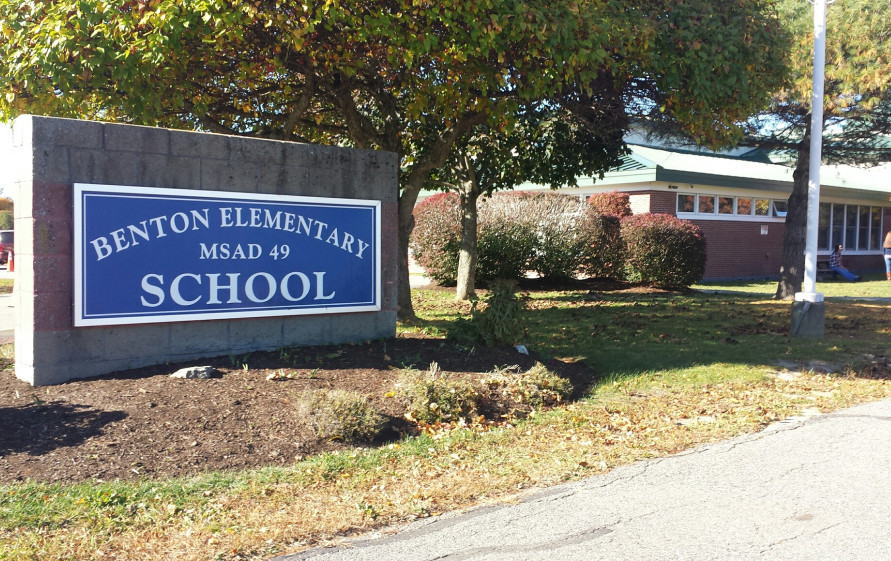BENTON — The Kennebec Water District has found dangerously high levels of lead in water used at Benton Elementary School in a test conducted Friday, prompting the school to turn off drinking fountains and the state to investigate potential risks.
The water district tested three sites in the school, finding results more than 40 times the limit at which action is needed. There were 670 parts per billion at a faucet near the cafeteria, 57 parts per billion at a faucet in a first-floor classroom and 78 parts per billion at a faucet in a second-floor classroom, according to Jeff LaCasse, general manager of the district. The action level for lead in water in schools is 15 parts per billion.
The water district received the results Tuesday evening and notified Fairfield-based School Administrative District 49 about the problem Wednesday morning. Benton Elementary shut down its drinking fountains and told teachers to instruct students to use bottle water dispensers instead of faucets and fountains, according to Superintendent Dean Baker.
The school is shutting off its water for sometime on Thursday as part of an investigation to determine whether the water is becoming contaminated before it enters the school or afterward, Baker said. There is no way of knowing now how long it will take to solve the problem, he said.
“We have no idea what the source is,” LaCasse said. He said the water district was “really surprised” at the levels it found.
As precautionary steps, the school superintendent said plumbers changed the faucets and fittings in the kitchen, which sometimes contain lead and can be the source of contamination, and the district is testing at Lawrence Junior and Senior High schools.
Toxicologists in the state Department of Health and Human Services are running a risk assessment on the case, according to spokeswoman Samantha Edwards.
“Sources of lead are likely fixtures, water fountains, lead solder, etc. that leach lead into the water in the school’s plumbing system,” Edwards said in an emailed statement Wednesday. “The only way to know if there is lead in water is to test. If high levels of lead are found, the next step is to eliminate or reduce the sources.”
The ban on drinking water from the school “eliminates” the risk to children, she said.
Poland Spring also responded to the emergency, both donating and delivering eight water bubblers and about 20 5-gallon jugs of water to the school. More will be delivered tomorrow, Baker said.
“I’m very appreciative that the Nestle Corporation has volunteered to donate several water coolers,” he said. Maine Paper and Janitorial Products, based in Bangor, is also donating 10,000 paper cups that will arrive Thursday.
Meanwhile, letters were sent home to parents Wednesday with information about why the school restricted drinking water supplies.
Outside the school Wednesday afternoon, two mothers expressed concern as well as relief at the school’s and others’ quick actions.
“I’m pretty glad that Poland Springs helped out,” Jen King said. “I’m glad the school’s taking steps.”
Michelle Grass said a big question on her mind is how long has the lead been there, and how much could the children already have consumed.
Right now, LaCasse said there isn’t a way to determine how long the lead levels were so high, but Baker said the school district will investigate the “degree and length of exposure.”
Benton Elementary School also is developing a plan to solve the problem, Baker said.
“Our first priority is to eliminate the source of the problem and correct it so it doesn’t happen again,” he said.
The school was built in 1957, when lead often wasn’t thought about. In the 1990s, when lead soldering was banned, the school was updated and enlarged. LaCasse said some fixtures, such as faucets, still might have some lead content in them.
The water district treats water with corrosion additives that reduce the potential for lead leaching into the water, according to information provided by LaCasse. Still, lead often can seep in after it leaves the public plumbing system by way of plumbing fixtures and lead solder used to connect pipes that can dissolve into the water, he said.
The water district was testing the water as a “goodwill gesture” in response to the national spotlight on Flint, Michigan, where high levels of lead were found coming from lead-service pipes. The district does not have lead service lines; they’re made of copper, LaCasse said.
The water district is required to test only sites that are in a risk category of Tier 1, which all happen to be residences, LaCasse said.
But district trustees and staff “felt that it would be important for us to assure people in our system that school-age children were not receiving water with unacceptable lead content.”
“Children are most susceptible to the effects of high lead levels,” LaCasse said.
Lead can cause developmental delays in children both physically and mentally, as well as kidney problems and high blood pressure in adults, according to the website of the Maine Division of Environmental Health.
The tests cost about $20, so the time and effort it takes to set them up is the largest burden to the district, LaCasse said.
In June, the water district tested five elementary schools in Waterville, Winslow, Fairfield and Benton, which did not include Benton Elementary School. A second round of sampling was conducted Oct. 14.
The highest level the water district found in other schools was 3.7 parts per billion.
Madeline St. Amour — 861-9239
mstamour@centralmaine.com
Twitter: @madelinestamour
Send questions/comments to the editors.




Comments are no longer available on this story